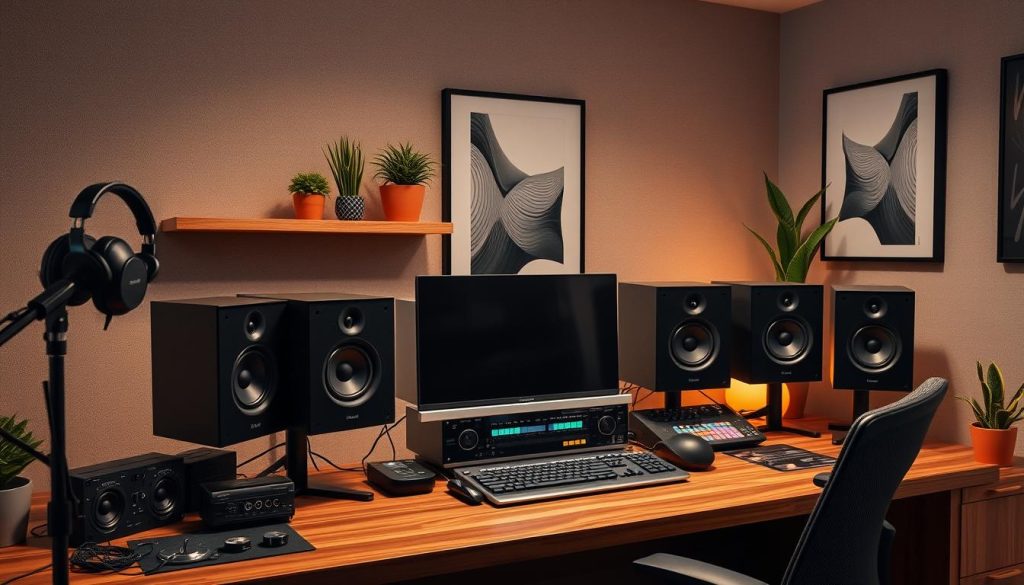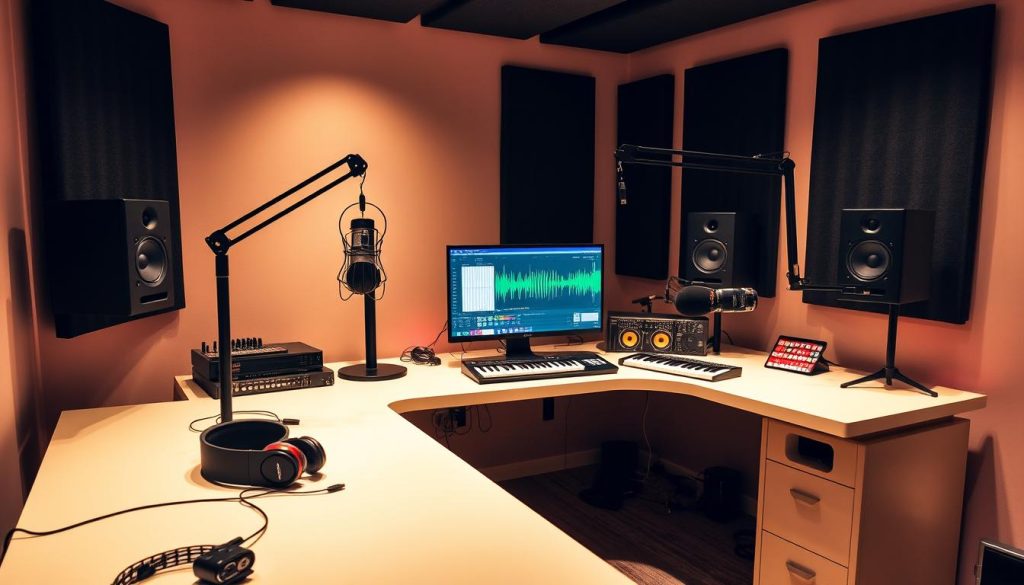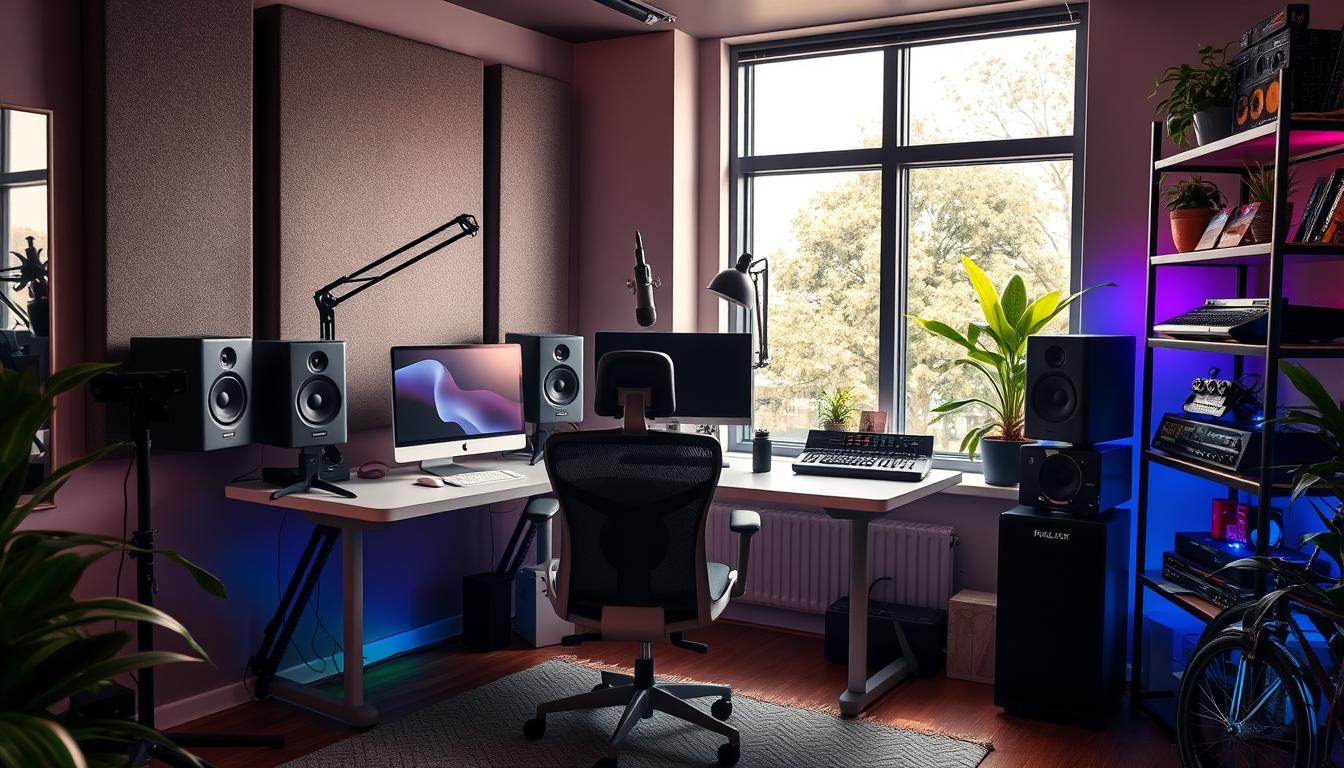Setting up a home studio is easier now for musicians and audio engineers. But, it can still feel hard, especially for beginners. This guide will help you pick the right gear for a professional home studio. You’ll learn how to make your recordings sound clear and deep.
We’ll start with the computer and digital audio workstation you need. Then, we’ll talk about monitor speakers and making your room sound better. By the end, you’ll know what gear you need for a great home studio.
Establish Your Budget
Setting up your home studio starts with a realistic budget. The cost of music production gear varies a lot. Knowing your budget helps you make smart choices.
A good studio is made of many parts. No single item makes your work great. With a budget, you can find the right mix of quality and cost for your studio.
First, think about how much money you can spend on your studio. Your money, goals, and how you plan to use your studio matter. This step is key for getting the best from your music production equipment cost.
After setting your budget, look into the gear you need. You’ll want a strong computer and good speakers. Knowing your budget helps you choose wisely and avoid spending too much.
Finding the right mix of performance and cost is key for a great home studio. With a good budget, you can make a professional space that fits your budget. This will help you build the studio you dream of.
Choose a Powerful Computer
At the heart of any successful home studio is a strong computer. This machine does the heavy lifting for recording, playback, and running software. When picking a computer, think about processing power, RAM, and storage.
Factors to Consider
First, choose a computer with many processor cores and lots of RAM, at least 8GB. This helps your computer handle music production tasks smoothly. Also, go for a solid-state drive (SSD) over a traditional hard disk drive. SSDs are faster and more reliable.
Your computer also needs to connect to important gear like your audio interface and MIDI controller. By looking at these things, you can make a music production PC that’s strong and ready for the future.
| Component | Recommended Specifications |
|---|---|
| Processor | Multi-core processor (e.g., Intel Core i7 or AMD Ryzen 7) |
| RAM | Minimum 8GB, but preferably 16GB or more |
| Storage | Solid-state drive (SSD) for faster boot and application loading times |
| Connectivity | Multiple USB ports, MIDI connections, and compatible audio interface |
Select a Digital Audio Workstation (DAW)
Choosing a digital audio workstation (DAW) is a big decision for your home studio. It’s the software that lets you record, edit, and mix your music. You can pick from many options like Pro Tools, Logic, Ableton Live, Cubase, and Garageband.
Each DAW has its own strengths and features. Think about these things when picking one for your studio:
- Make sure it works with your computer (Windows or macOS)
- Look at the features that fit your music making style
- Choose one you’re comfortable using
The DAW you pick can change how you make music and how efficient you are. Do your homework and see which one fits you best.
| Digital Audio Workstation | Operating System Compatibility | Key Features |
|---|---|---|
| Pro Tools | Windows, macOS | Industry-standard audio editing, mixing, and recording capabilities |
| Logic Pro | macOS | Powerful built-in instruments, effects, and advanced MIDI features |
| Ableton Live | Windows, macOS | Innovative session-based workflow, great for electronic music production |
| Cubase | Windows, macOS | Comprehensive suite of audio editing and MIDI tools, versatile for various genres |
| GarageBand | macOS | User-friendly interface, great for beginners and hobbyists |
Choosing the right DAW is key to your music production journey. Take time to think about what you need and what’s out there. Find the perfect fit for your creative process.
Invest in Quality Monitor Speakers

When you set up your home music studio, your monitor speakers are key. They affect every choice you make in music production. So, it’s vital to choose quality speakers. Look for ones that give you accurate sound, not just loud bass or treble.
Monitor Speaker Considerations
When looking for monitor speakers, think about these things:
- Budget – Spending more on good speakers can help you make better music later.
- Room size – Big rooms need speakers that can fill them with clear sound.
- Frequency response – Choose speakers that don’t change your music’s sound.
- Connectivity – Make sure speakers have many ways to connect, like XLR, TRS, and RCA.
Even if you have to cut back in other areas, investing in great monitor speakers is a smart move. It sets a strong base for your music making.
| Monitor Speaker | Frequency Response | Power Output | Price |
|---|---|---|---|
| Yamaha HS5 | 54Hz – 30kHz | 70W | $299 (per speaker) |
| Kali Audio IN-5 | 45Hz – 20kHz | 80W | $249 (per speaker) |
| JBL 305P MkII | 49Hz – 20kHz | 82W | $149 (per speaker) |
Treat Your Room Acoustically
Setting up a home studio means making sure your room sounds good. Soundproofing keeps sound from leaking in or out. But, acoustic treatment helps control how sound moves in the room. This makes your speakers sound better and more accurate.
DIY acoustic panels are a great way to improve your studio’s sound. They use rigid fiberglass to soak up sound. Even without full soundproofing, these panels can make a big difference in how you hear your music.
- Identify and address issues like bass buildup and flutter echo
- Utilize cost-effective DIY acoustic panels to improve room acoustics
- Focus on enhancing the accuracy and performance of your monitor speakers
Putting effort into home studio acoustic treatment really helps your music sound better. By learning about room acoustics and using DIY acoustic panels, you can make your home studio sound professional.
home studio gear

Setting up a pro home studio means getting the right gear. You need a powerful computer and top-notch microphones. These are key for making music at a pro level.
Your computer is the heart of your studio. It should have strong processing power, lots of storage, and be reliable. This helps with running digital audio workstations (DAWs) and music production software. Then, pair it with a versatile DAW like Pro Tools, Logic Pro, or Ableton Live for recording, editing, and mixing.
Good speakers are vital for listening to your audio. Look for speakers that give you accurate sound. This helps you make smart mixing choices. Also, get an audio interface to connect your gear smoothly and with low delay.
To finish your studio, get different microphones for various sounds. MIDI controllers, like keyboards and drum pads, can also boost your creativity and music production skills.
Don’t forget to treat your recording space well for a pro sound. With the right gear, you can make music at the highest level from home.
Key Home Studio Gear to Consider
- Powerful computer with ample processing power and storage
- Digital Audio Workstation (DAW) software for recording, editing, and mixing
- High-quality monitor speakers for accurate audio monitoring
- Audio interface to connect microphones, instruments, and speakers
- Diverse collection of microphones for capturing various sound sources
- MIDI controllers, such as keyboards and drum pads, for enhanced music production
- Proper acoustic treatment of the recording space for a professional-sounding mix
Optimize Your Workspace
Setting up your home studio means more than just picking the right audio gear. The way your workspace looks and feels is key to your productivity and health. A well-designed music production area can boost your creativity and help you work better.
Studio Desk and Chair
Your workspace starts with a good studio desk. Choose a desk that’s strong and has enough room for your computer, monitor, and other gear. Don’t forget an ergonomic chair with great lumbar support to keep your back and neck happy.
When picking a home studio desk, think about these things:
- Enough space for your music production workstation
- Adjustable height for an ergonomic studio setup
- Strong build to hold your gear
- Looks good with your space
Adding an ergonomic chair to your home studio desk setup is smart. Look for a chair with these features:
- Adjustable seat and backrest for good posture
- Lumbar support to ease back pain
- Swivel and caster for easy movement
- Material that breathes for comfort
Choosing a great home studio desk and ergonomic chair makes your music production area look and feel professional. It also supports your health, letting you focus better on your music.
Add Personal Touches
Adding personal touches to your home studio is key. It boosts your creativity. Think about adding houseplants, LED lighting, or art that matches your music style. These items make your studio a happier place to work.
Decorating your studio with things you love makes it special. You could show off gear from your favorite brands or hang your own art. This makes your space feel like it belongs to you. It also makes you proud of your home recording area.
Creating a space that motivates you is the goal. By adding things you love, you make a place that helps your creativity grow. Don’t be afraid to try new things. Find the mix of function and personal style that works for you.

